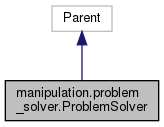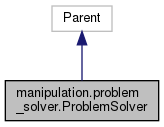Definition of a manipulation planning problem. More...


Public Member Functions | |
| def | __init__ (self, robot) |
| def | selectProblem (self, name) |
| Select a problem by its name. More... | |
| def | getAvailable (self, type) |
| Return a list of available elements of type type. More... | |
| def | getSelected (self, type) |
| Return a list of selected elements of type type. More... | |
Contact surfaces | |
In placement states, objects are in contact with other objects or with the environment through contact surfaces. | |
| def | getEnvironmentContactNames (self) |
| def | getRobotContactNames (self) |
| def | getEnvironmentContact (self, name) |
| def | getRobotContact (self, name) |
Constraints | |
| def | createPlacementConstraints (self, placementName, shapeName, envContactName, width=0.05) |
| Create placement and pre-placement constraints. More... | |
| def | balanceConstraints (self) |
| Return balance constraints created by method ProblemSolver.createStaticStabilityConstraints. More... | |
| def | getConstantRightHandSide (self, constraintName) |
| Get whether right hand side of a numerical constraint is constant. More... | |
| def | lockFreeFlyerJoint (self, freeflyerBname, lockJointBname, values=(0, 0, 0, 0, 0, 0, 1)) |
| Lock degree of freedom of a FreeFlyer joint. More... | |
| def | lockPlanarJoint (self, jointName, lockJointName, values=(0, 0, 1, 0)) |
| Lock degree of freedom of a planar joint. More... | |
Solve problem and get paths | |
| def | setTargetState (self, stateId) |
| Set the problem target to stateId The planner will look for a path from the init configuration to a configuration in state stateId. More... | |
Detailed Description
Definition of a manipulation planning problem.
This class wraps the Corba client to the server implemented by libhpp-manipulation-corba.so
Some method implemented by the server can be considered as private. The goal of this class is to hide them and to expose those that can be considered as public.
Constructor & Destructor Documentation
◆ __init__()
| def manipulation.problem_solver.ProblemSolver.__init__ | ( | self, | |
| robot | |||
| ) |
Member Function Documentation
◆ balanceConstraints()
| def manipulation.problem_solver.ProblemSolver.balanceConstraints | ( | self | ) |
Return balance constraints created by method ProblemSolver.createStaticStabilityConstraints.
◆ createPlacementConstraints()
| def manipulation.problem_solver.ProblemSolver.createPlacementConstraints | ( | self, | |
| placementName, | |||
| shapeName, | |||
| envContactName, | |||
width = 0.05 |
|||
| ) |
Create placement and pre-placement constraints.
- Parameters
-
width set to None to skip creation of pre-placement constraint
See hpp::corbaserver::manipulation::Problem::createPlacementConstraint and hpp::corbaserver::manipulation::Problem::createPrePlacementConstraint
◆ getAvailable()
| def manipulation.problem_solver.ProblemSolver.getAvailable | ( | self, | |
| type | |||
| ) |
Return a list of available elements of type type.
- Parameters
-
type enter "type" to know what types I know of. This is case insensitive.
◆ getConstantRightHandSide()
| def manipulation.problem_solver.ProblemSolver.getConstantRightHandSide | ( | self, | |
| constraintName | |||
| ) |
Get whether right hand side of a numerical constraint is constant.
- Parameters
-
constraintName Name of the numerical constraint,
- Returns
- whether right hand side is constant
◆ getEnvironmentContact()
| def manipulation.problem_solver.ProblemSolver.getEnvironmentContact | ( | self, | |
| name | |||
| ) |
Get environment contact from name
A contact surface may be composed of several convex polygons. Let us denote by n the number of polygons.
- Parameters
-
name name of the contact surface
- Returns
- a list of n times the same joint name
- Return values
-
indices sequence of n numbers of vertices one for each polygon, points sequence of vertices. The number should be the sum of the elements of indices.
◆ getEnvironmentContactNames()
| def manipulation.problem_solver.ProblemSolver.getEnvironmentContactNames | ( | self | ) |
Get names of environment contact surfaces
- See also
- class hpp::core::Shape_t
- Note
- they are also accessible with getAvailable("EnvContact").
◆ getRobotContact()
| def manipulation.problem_solver.ProblemSolver.getRobotContact | ( | self, | |
| name | |||
| ) |
Get robot contact from name
A contact surface may be composed of several convex polygons. Let us denote by n the number of polygons.
- Parameters
-
name name of the contact surface
- Returns
- a list of n times the same joint name
- Return values
-
indices sequence of n numbers of vertices one for each polygon, points sequence of vertices. The number should be the sum of the elements of indices.
◆ getRobotContactNames()
| def manipulation.problem_solver.ProblemSolver.getRobotContactNames | ( | self | ) |
Get names of environment contact surfaces on robot
- See also
- class hpp::core::Shape_t
- Note
- those are also accessible with getAvailable("RobotContact").
◆ getSelected()
| def manipulation.problem_solver.ProblemSolver.getSelected | ( | self, | |
| type | |||
| ) |
Return a list of selected elements of type type.
- Parameters
-
type enter "type" to know what types I know of. This is case insensitive.
- Note
- For most of the types, the list will contain only one element.
◆ lockFreeFlyerJoint()
| def manipulation.problem_solver.ProblemSolver.lockFreeFlyerJoint | ( | self, | |
| freeflyerBname, | |||
| lockJointBname, | |||
values = (0,0,0,0,0,0,1) |
|||
| ) |
Lock degree of freedom of a FreeFlyer joint.
- Parameters
-
freeflyerBname base name of the joint (It will be completed by '_xyz' and '_SO3'), lockJointBname base name of the LockedJoint constraints (It will be completed by '_xyz' and '_SO3'), values config of the locked joints (7 float)
◆ lockPlanarJoint()
| def manipulation.problem_solver.ProblemSolver.lockPlanarJoint | ( | self, | |
| jointName, | |||
| lockJointName, | |||
values = (0,0,1,0) |
|||
| ) |
Lock degree of freedom of a planar joint.
- Parameters
-
jointName name of the joint (It will be completed by '_xy' and '_rz'), lockJointName name of the LockedJoint constraint values config of the locked joints (4 float)
◆ selectProblem()
| def manipulation.problem_solver.ProblemSolver.selectProblem | ( | self, | |
| name | |||
| ) |
Select a problem by its name.
If no problem with this name exists, a new hpp::manipulation::ProblemSolver is created and selected.
- Parameters
-
name the problem name.
- Returns
- true if a new problem was created.
◆ setTargetState()
| def manipulation.problem_solver.ProblemSolver.setTargetState | ( | self, | |
| stateId | |||
| ) |
Set the problem target to stateId The planner will look for a path from the init configuration to a configuration in state stateId.
The documentation for this class was generated from the following file:
- src/hpp/corbaserver/manipulation/problem_solver.py
